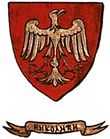Nikolić noble family
| Nikolić | |
|---|---|
 | |
| Country |
|
| Estates | Popovo Polje |
| Titles | Knez |
| Founded | before 1363 |
| Dissolution | 1453 (last mention) |
| Ethnicity | Serb |
The Nikolić was a Serbian medieval noble family from Hum (Herzegovina). The family's main estate was Popovo Polje.
History
The progenitor of the family was Nikola, a župan, a descendant of Andrija of Hum (s. 1243–49) and Miroslav of Hum (s. 1166–90).[1] The family was thus related to the Nemanjić dynasty.[2] Nikola had two sons by Katarina, the daughter of Stephen I, Ban of Bosnia: Vladislav and Bogiša.[2]
However, little is known about the first ancestors of the Nikolić family, being last mentioned in 1363, though they most likely were governors in Hum. With princess Vukosava, Petar and Miliša Nikolić begin the second generation of the Nikolić family. It is known that their mother was a woman named Stanislava, but it is not certain who their father was, whether it was either Vladimir or Bogiša. Recent studies suggest that since Vladimir was older, and from other sources, we are able to assume that he was the father of three known princes. The mention of the Nikolić brothers begin after the death of King Tvrtko I of Bosnia in 1391. As adherents of the new Bosnian king, Stephen Dabiša, their reputation visually rose that by December of 1392, the Republic of Dubrovnik granted them citizenship. Stephen Ostoja's rise to the Bosnian throne found the Nikolić brothers in an unpredicted position, as they were adherents to Queen Jelena Gruba, who was of the House of Nikolić herself and widow of Stephen Dabiša. This caused a problem as they now had to constrainedly find refuge in Dubrovnik. Vukosav later participated in the Bosnian-Ragusan War (1403) as a nobleman of Duke Sandalj Hranić. Vukosav was killed in a skirmish with the Ragusans and was buried in Ston on 28 November 1403.
Grgur Vukosalić, the son of Vukosav Nikolić, was present at historical events in Bosnia in the course of Tvrtko II's campaign against King Stephen Ostoja. Until the independence of Grgur Vukosalić a civil war for control of the Bosnian government came, currently headed by King Stephen Ostojić of Bosnia. As Vukosalić was on Ban Ostojić's side, he directly turned his back on his own lord, Sandalj Hranić. Through Dubrovnik's aid, passions calmed and the Nikolić family ceased trying to gain independence from the Bosnian duke. After Hranić's death, the Nikolić family was loyal to his successor, Stjepan Vukčić Kosača. Grgur died in July 1436.
The sons of Grgur Vukosalić, Vuk and Vukašin Grgurević, continued the same attitude toward Stjepan Vukčić Kosača. Vukašin Grgurević was under Kosača in his efforts to overtake Zeta. In 1442, Vukasin fell into Venetian captivity, but through the help of Dubrovnik, he was freed. The last mention of the Nikolić family was in 1453, where they were still under the lordship of Stjepan Vukčić Kosača. The Ottoman Empire had already started its conquest of Europe and posed a major threat to the Balkans throughout the first half of the 15th century. Finally, after decades of political and social instability, Bosnia officially fell in 1463. Herzegovina would follow in 1482, with a Hungarian-backed reinstated "Bosnian Kingdom" being the last to succumb in 1527. After the end of Bosnia, Nikolićs were left on their own to fight for survival. However, their fate is little known until the 18th century.
Members
- Family tree
- Nikola, župan
- Vladislav (fl. 1347–1363)
- Vukosav Nikolić (fl. 1395–d. 1403),
- Grgur Nikolić (fl. 1403–d. 1436), knez
- Vuk Nikolić
- Vukašin Nikolić
- Radoje Nikolić, vojvoda
- Grgur Nikolić (fl. 1403–d. 1436), knez
- Vukosav Nikolić (fl. 1395–d. 1403),
- Bogiša (fl. 1347–1363)
- Vladislav (fl. 1347–1363)
- Unknown genealogy
- Jovan
- Bogdan
- Miliša (fl. 1392)
- Jelena Gruba (ca. 1345–d. after March 18, 1399), Queen of Bosnia from 1391 to 1398, first as queen consort until 1395 and then as queen regnant.
References
- ↑ Ljubo Mihić (1975). Ljubinje sa okolinom. Dragan Srnic. p. 798.
- ↑ 2.0 2.1 Herta Kuna (1974). Starija književnost. Zavod za izdavanje udžbenika. p. 93.
| ||||||||||||||||||||||